Heinrich J.G., Aldinger F. (Eds.) Ceramic Materials and Components for Engines
Подождите немного. Документ загружается.


This Page Intentionally Left Blank

PROPERTIES
OF
SILICON NITRIDE/CARBIDE NANOMICRO-
COMPOSITES
-
ROLE
OF
Sic NANOINCLUSIONS AND GRAIN
BOUNDARY CHEMISTRY
P.
sajgalik,
M.
Hnatko,
Z.
Len&%
Institute
of
Inorganic Chemistry, Slovak Academy
of
Sciences, Diibravskh cesta
9,
SK-842
36
Bratislava, Slovak Republic
ABSTRACT
Two different types of Sic nano-inclusions were
identified
within
the Si3N4/SiC nano/micro composite.
Sic
with
the oxygen rich interface is created by the
reduction of Si02 present
in
the silica melt and the Sic
inclusion
with
,,clean" interface is created by the
precipitation of SiCN amorphous powder. The first
type of nano-inclusion influences the high-temperature
properties while the second one affected the room-
temperature properties of the composite.
INTRODUCTION
SiC/Si3N4 nano/micro composites are intensively
studied during the last decade
[
1-61. Good room as well
as high temperature properties are reported for these
materials. The background of their excellent
mechanical properties is widely discussed from their
introduction by Niihara,
[I].
Nano/micro composites
consist of Si3N4 micro-grains and Sic nano-inclusions,
which are located within the host Si3N4 grains and on
their grain boundaries. As
it
was reported
in
the works
of Pan et al. and Sajgalik et al. [7,
81,
not only position
of
nano-grains is different (grain boundary and grain
inside) but also the surface chemistry. The Sic nano-
inclusions with a "clean" surface and the inclusions
containing the oxygen rich surface layer were reported.
Sic nano-inclusion origin and the role with respect to
the mechanical behavior of composites is not clear yet
in spite
of
the fact, that Pan suggested the hypothesis of
their formation,
[7].
Hypothesis of Pan was based on
the size effect of the nano-inclusions. Based on a model
experiment, the present paper shows the origin
of
inclusions and discusses the effect of both types of
inclusions on the mechanical behavior of the
composite.
EXPERIMENTAL
SiC/Si3N4 nano/micro-composites were prepared
by seeding of the starting powder with amorphous
SiCN fine powder, Table
1.
Amorphous SiCN powder,
with calculated composition given in the Table 2, was
added together with the alumina (Alcoa, USA, grade
A16) and/or yttria (H.C. Starck, Germany, grade Fine)
in
the amount listed in Table 1 to the crystalline Si3N4
powder (UBE Industries, Ltd., Japan, grade SN-E10).
The powders were attrition milled
in
isopropanol for
4
h.
Dried powder mixtures SNYA and SNYAIO,
respectively (Table
1)
were cold isostatically pressed
(CIP) at a pressure of 750 MPa. The CIPed samples
were gas pressure sintered in BN crucible at 1900 "C
for 2 h
in
a nitrogen atmosphere
of
10
MPa. The
density of samples measured by the water immersion
method was
>
99
%
theoretical density (TD). Samples
SNY and SNY20, respectively (Table
1)
were cold
pressed in the steel die with the pressure of
100
MPa,
then embedded into the BN and hot-pressed by pressure
of 30 MPa at 1750 "C and 0.2 bar over-pressure
of
nitrogen. Density of hot-pressed samples were
measured by mercury immersion method and for all
samples was
>
98
%
TD. The bars of (45
x
4
x
3)
m
for mechanical testing were cut from densified prisms
(50 x 15
x
10)
mm
after gas pressure sintering and
discs (50 mm diameter and
5
nun
height) after hot
pressing, respectively. The
bars
with tensile surface
polished to 15 pm finish were used for the 4-point
bending tests (20/40 innedouter span, cross-head speed
O.Smm/min) at room temperature.
Table
1
Composition and sintering method used
in
processing of samples for RT and HT measurements.
Properties Sample Sintering Si3N4 A1203 Y203 amorph SiCN
method wt% wt.
%
wt.
%
wt.
%
RT
SNYA
GPS 92 3.4 4.6
RT
SNYAlO
GPS
82
3.4
4.6
10
HT
SNY
HP 95
5
HT
SNYZO
HP 75
5 20
1900 "C12 h
1900 "C/2 h
1750 "C/2
h
1750 "C/2
h
553
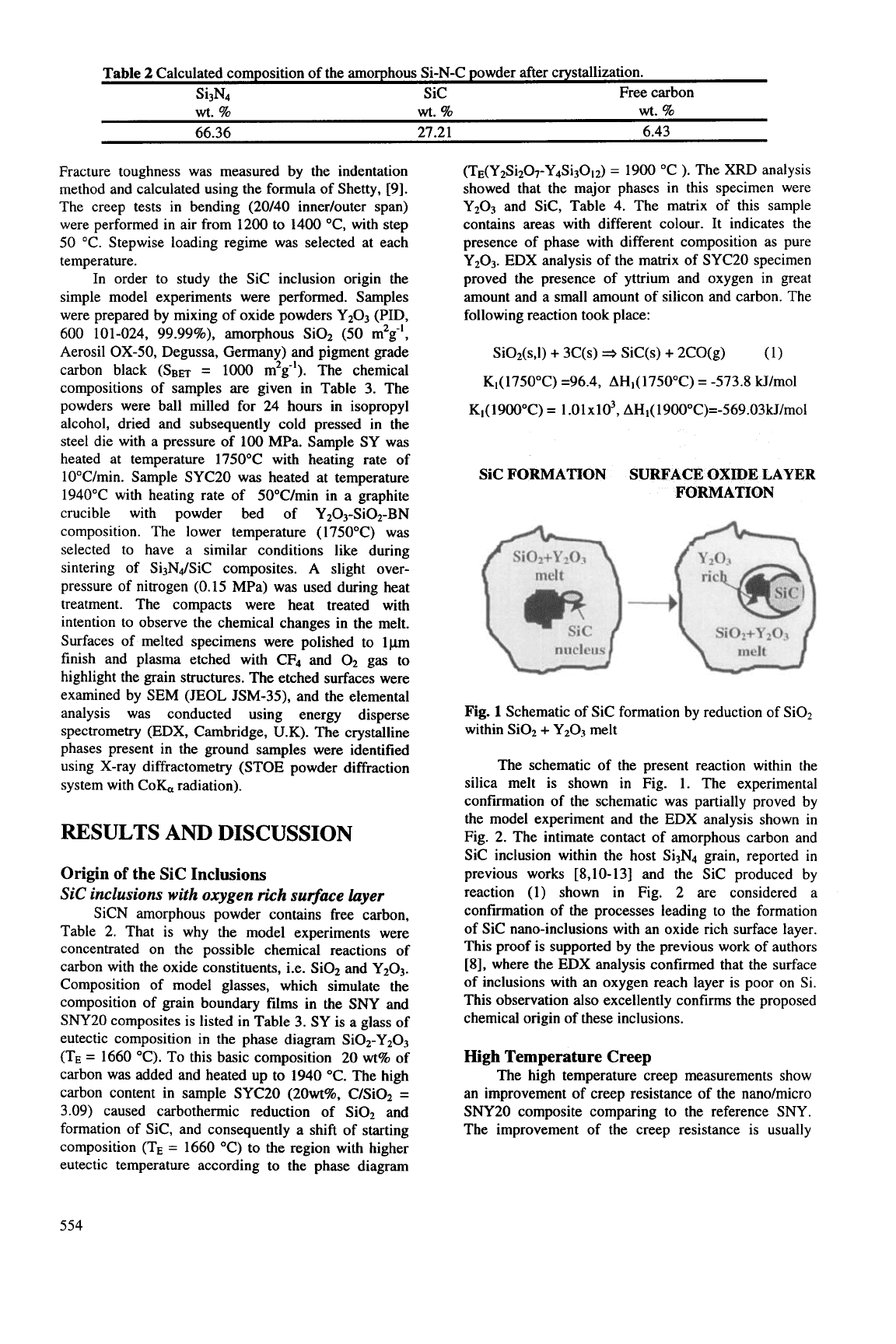
Table
2
Calculated composition of the amorphous Si-N-C powder after crystallization.
Si3N4 Sic Free carbon
wt.
%
wt.
%
wt.
%
66.36 27.21 6.43
Fracture toughness was measured by the indentation
method and calculated using the formula of Shetty, [9].
The creep tests in bending (20/40 innedouter span)
were performed in air from 1200 to 1400 "C, with step
50
"C. Stepwise loading regime was selected at each
temperature.
In order to study the Sic inclusion origin the
simple model experiments were performed. Samples
were prepared by mixing of oxide powders Y2O3 (PID,
600 101-024, 99.99%), amorphous SiOz
(50
m'g-',
Aerosil OX-50, Degussa, Germany) and pigment grade
carbon black (SBET
=
lo00
m'g-'). The chemical
compositions of samples are given in Table
3.
The
powders were ball milled for 24 hours in isopropyl
alcohol, dried and subsequently cold pressed in the
steel die with a pressure
of
100 MPa. Sample SY was
heated at temperature 1750°C with heating rate of
10"C/min. Sample SYC20 was heated at temperature
1940°C with heating rate of 5O"C/min in a graphite
crucible with powder bed of YzO3-SiO2-BN
composition. The lower temperature (1750°C) was
selected to have a similar conditions like during
sintering of Si3NdSiC composites.
A
slight over-
pressure of nitrogen (0.15 MPa) was used during heat
treatment. The compacts were heat treated with
intention to observe the chemical changes in the melt.
Surfaces of melted specimens were polished to lpn
finish and plasma etched with CF, and
02
gas to
highlight the grain structures. The etched surfaces were
examined by SEM (JEOL JSM-35), and the elemental
analysis was conducted using energy disperse
spectrometry (EDX, Cambridge,
U.K).
The crystalline
phases present in the ground samples were identified
using X-ray diffractometry (STOE powder diffraction
system with COG radiation).
RESULTS
AND
DISCUSSION
Origin
of
the Sic Inclusions
SIC inclusions with oxygen
rich
surface layer
SiCN amorphous powder contains free carbon,
Table
2.
That is why the model experiments were
concentrated on the possible chemical reactions of
carbon with the oxide constituents, i.e. Si02 and YzO3.
Composition of model glasses,
which simulate the
composition
of
grain boundary films in the SNY and
SNY20 composites is listed in Table
3.
SY is a glass of
eutectic composition
in
the phase diagram Si02-Yz03
(TE
=
1660 "C). To this basic composition 20
wt%
of
carbon was added and heated up to 1940 "C. The high
carbon content in sample SYC20 (20wt%, C/Si02
=
3.09) caused carbothennic reduction of SiOz and
formation of Sic, and consequently a shift of starting
composition (TE
=
1660 "C) to the region with higher
eutectic temperature according to the phase diagram
(TE(YzSiz07-Y4Si301z)
=
1900 "C
).
The XRD analysis
showed that the major phases in this specimen were
YzO3 and Sic, Table 4. The matrix of this sample
contains areas with different colour. It indicates the
presence of phase with different composition as pure
YzO3. EDX analysis of the matrix of SYC20 specimen
proved the presence of yttrium and oxygen
in
great
amount and a small amount of silicon and carbon. The
following reaction took place:
SiOz(s,l)
+
3C(s)
3
SiC(s)
+
2CO(g)
(1)
KI(
1750°C) =96.4,
AH1(
1750°C)
=
-573.8 kJ/mol
K1(1900"C)
=
l.01x103,
AH1(1900"C)=-569.03kJ/mol
SIC
FORMATION SURFACE
OXIDE
LAYER
FORMATION
Fig.
1
Schematic of Sic formation by reduction of SiOz
within SiOz
+
YzO3
melt
The schematic of the present reaction within the
silica melt is shown
in
Fig. 1. The experimental
confirmation
of
the schematic was partially proved by
the model experiment and the EDX analysis shown
in
Fig. 2. The intimate contact of amorphous carbon and
Sic inclusion within the host Si3N4 grain, reported
in
previous works [8,10-131 and the Sic produced by
reaction (1) shown
in
Fig. 2 are considered a
confirmation of the processes leading to the formation
of Sic nano-inclusions with an oxide rich surface layer.
This proof is supported by the previous work of authors
[8], where the EDX analysis confirmed that the surface
of inclusions with an oxygen reach layer is poor on Si.
This observation also excellently confirms the proposed
chemical origin of these inclusions.
High Temperature Creep
The high temperature creep measurements show
an improvement of creep resistance of the nano/micro
SNY20 composite comparing to the reference SNY.
The improvement of the creep resistance is usually
554
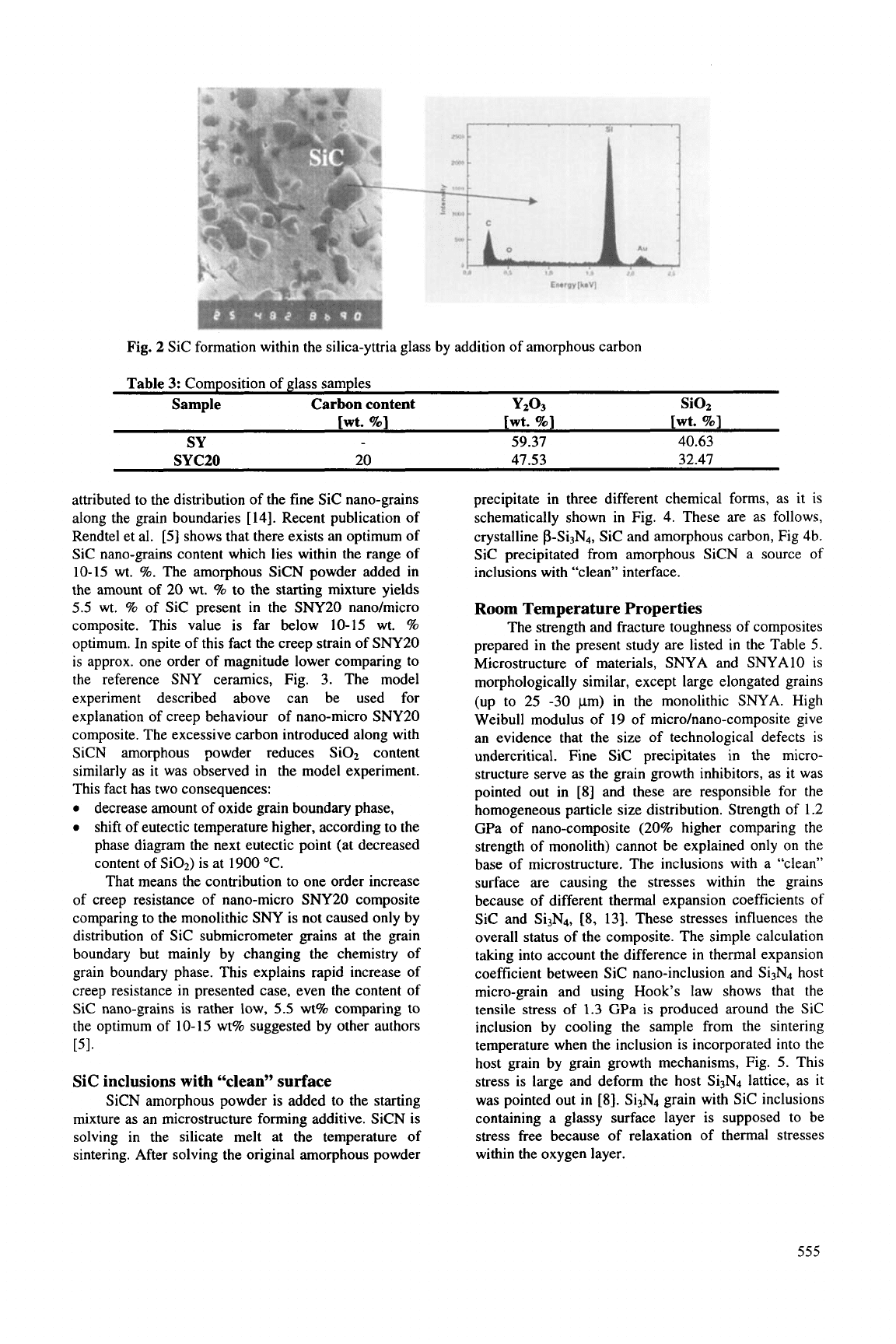
Fig.
2
Sic formation within the silica-yttria glass by addition of amorphous carbon
Table
3:
Composition of glass samples
Sample Carbon content
y203
Si02
SY
59.37 40.63
SYC20
20 47.53 32.47
[wt.
Yo]
[wt.
Yo]
[wt.
Yo]
attributed to the distribution of the
fine
Sic nano-grains
along the grain boundaries
[
141. Recent publication of
Rendtel et al.
[5]
shows that there exists an optimum of
Sic nano-grains content which lies within the range of
10-15
wt.
%.
The amorphous SiCN powder added in
the amount of 20 wt.
%
to the starting mixture yields
5.5
wt.
%
of Sic present in the SNY20 nanolmicro
composite. This value is far below 10-15 wt.
%
optimum. In spite of this fact the creep strain of SNY20
is approx. one order of magnitude lower comparing to
the reference SNY ceramics, Fig. 3. The model
experiment described above can be used for
explanation of creep behaviour of nano-micro SNY20
composite. The excessive carbon introduced along with
SiCN amorphous powder reduces SiOl content
similarly as
it
was observed
in
the model experiment.
This fact has two consequences:
decrease amount of oxide grain boundary phase,
shift of eutectic temperature higher, according to the
phase diagram the next eutectic point (at decreased
content of SOz) is at 1900 “C.
That means the contribution to one order increase
of creep resistance of nano-micro SNY20 composite
comparing to the monolithic SNY is not caused only by
distribution of Sic submicrometer grains at the grain
boundary but mainly by changing the chemistry of
grain boundary phase. This explains rapid increase of
creep resistance
in
presented case, even the content of
Sic nano-grains is rather low,
5.5
wt% comparing to
the optimum of
10-15
wt% suggested by other authors
[51.
SIC
inclusions
with
“clean” surface
SiCN amorphous powder is added to the starting
mixture as an microstructure forming additive. SiCN is
solving
in
the silicate melt at the temperature of
sintering. After solving the original amorphous powder
precipitate in three different chemical forms, as it is
schematically shown
in
Fig. 4. These are as follows,
crystalline p-Si3N4, Sic and amorphous carbon, Fig 4b.
Sic precipitated from amorphous SiCN a source of
inclusions with “clean” interface.
Room
Temperature Properties
The strength and fracture toughness of composites
prepared
in
the present study are listed
in
the Table
5.
Microstructure of materials, SNYA and SNYA10 is
morphologically similar, except large elongated grains
(up to 25 -30 pm) in the monolithic SNYA. High
Weibull modulus of 19 of microlnano-composite give
an evidence that the size of technological defects is
undercritical. Fine Sic precipitates in the micro-
structure serve as the grain growth inhibitors, as it was
pointed out
in
[8]
and these are responsible for the
homogeneous particle size distribution. Strength of
1.2
GPa of nano-composite (20% higher comparing the
strength of monolith) cannot be explained only on the
base of microstructure. The inclusions with a “clean”
surface are causing the stresses within the grains
because of different thermal expansion coefficients of
Sic and Si3N4,
[8,
131. These stresses influences the
overall status of the composite. The simple calculation
taking into account the difference
in
thermal expansion
coefficient between Sic nano-inclusion and Si3N4 host
micro-grain and using Hook’s law shows that the
tensile stress of
1.3
GPa
is
produced around the
Sic
inclusion by cooling the sample from the sintering
temperature when the inclusion is incorporated into the
host grain by grain growth mechanisms, Fig.
5.
This
stress is large and deform the host Si3N4 lattice, as
it
was pointed out in
[8].
Si3N4 grain with Sic inclusions
containing a glassy surface layer is supposed to be
stress free because of relaxation of thermal stresses
within the oxygen layer.
555
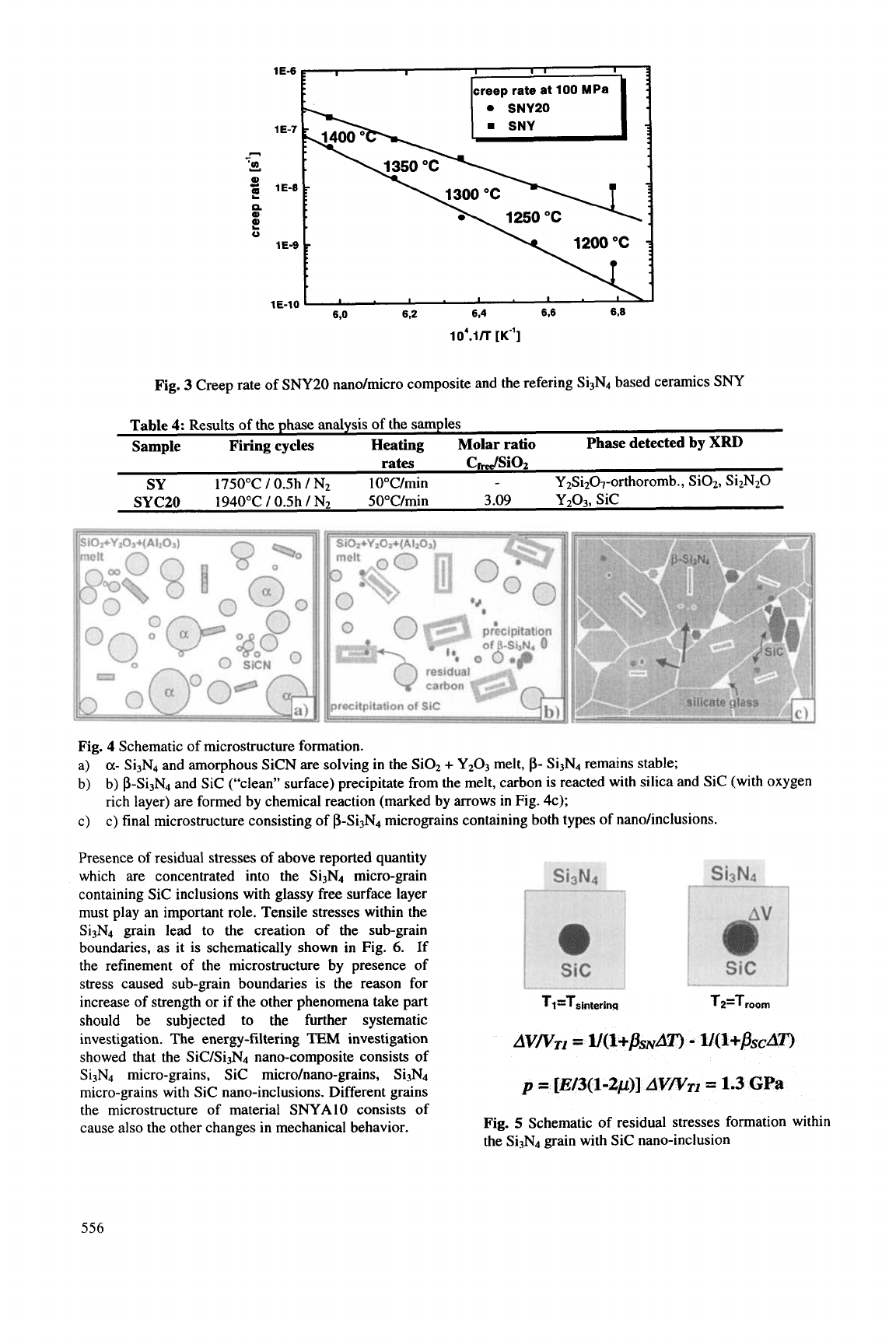
Fig.
3
Creep rate of SNY20 nano/micro composite and the refering Si3N4 based ceramics SNY
Table
4:
Results of the phase analysis
of
the samples
Sample Firing cycles Heating Molar ratio
Phase detected
by
XRD
rates CbJSiO2
SY
1750°C
/
0.5h
/
N2 10"C/min
Y2Si207-orthoromb., SiOz, Si2N20
SYCZO
1940°C
/
0.5h
/
N2 5O"C/min 3.09 Y2O3, Sic
Fig.
4
Schematic of microstructure formation.
a)
b)
c)
a-
Si3N4 and amorphous SiCN are solving in the Si02
+
Y203 melt,
p-
Si3N4 remains stable;
b) p-Si3N4 and Sic ("clean" surface) precipitate from the melt, carbon is reacted with silica and Sic (with oxygen
rich layer) are formed by chemical reaction (marked by arrows
in
Fig. 4c);
c)
final microstructure consisting of p-Si3N4 micrograins containing both types of nano/inclusions.
Presence
of
residual stresses
of
above reported quantity
which are concentrated into the Si3N4 micro-grain
containing Sic inclusions with glassy free surface layer
must play an important role. Tensile stresses within the
Si3N4 grain lead to the creation of the sub-grain
boundaries, as it
is
schematically shown in Fig.
6.
If
the refinement of the microstructure by presence of
stress caused sub-grain boundaries is the reason for
increase of strength
or
if the other phenomena take part
should be subjected to the
further
systematic
investigation. The energy-filtering
TEM
investigation
showed that the SiC/Si3N4 nano-composite consists of
TI=Tsinterinu
T2=7room
AVNn
=
l/(l+Ps~dT)
-
141+PscAn
Si3N4 micro-grains, Sic microhano-grains, Si3N4
micro-grains with Sic nano-inclusions. Different grains
p
=
[E/3(1-2p)]
AVWT~
=
1.3
GPa
the microstructure of material SNYAIO consists of
cause also the other changes in mechanical behavior.
Fig.
5
Schematic
of
residual stresses formation within
the Si3N4 grain with Sic nano-inclusion
556
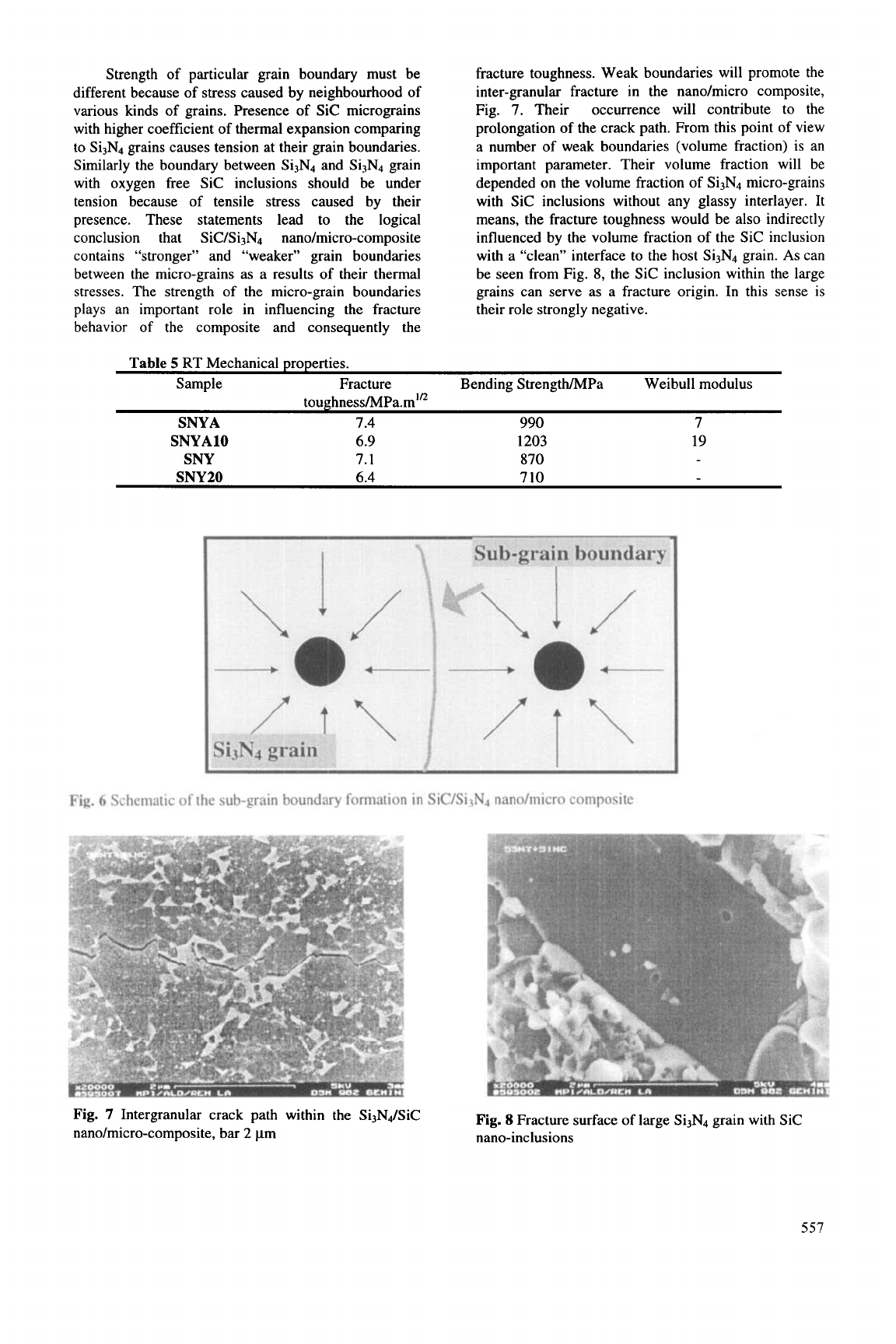
Strength
of
particular grain boundary must be
different because of stress caused by neighbourhood of
various kinds of grains. Presence of Sic micrograins
with higher coefficient of thermal expansion comparing
to Si3N4 grains causes tension at their grain boundaries.
Similarly the boundary between Si3N4 and Si3N4 grain
with oxygen free Sic inclusions should be under
tension because of tensile stress caused by their
presence. These statements lead to the logical
conclusion that SiC/Si3N4 nano/micro-composite
contains “stronger” and “weaker” grain boundaries
between the micro-grains as a results of their thermal
stresses. The strength of the micro-grain boundaries
plays an important role
in
influencing the fracture
behavior
of
the composite and consequently the
fracture toughness. Weak boundaries will promote the
inter-granular fracture
in
the nano/micro composite,
Fig.
7.
Their occurrence will contribute to the
prolongation of the crack path. From this point of view
a number of weak boundaries (volume fraction) is an
important parameter. Their volume fraction will be
depended on the volume fraction
of
Si3N4 micro-grains
with Sic inclusions without any glassy interlayer. It
means, the fracture toughness would be also indirectly
influenced by the volume fraction of the Sic inclusion
with a “clean” interface to the host Si3N4 grain.
As
can
be seen from Fig.
8,
the Sic inclusion within the large
grains can serve as a fracture origin. In this sense is
their role strongly negative.
Table
5
RT Mechanical properties.
Sample Fracture Bending StrengtMPa Weibull modulus
SNYA
7.4
990
7
SNYAlO
6.9
1203
19
toughness/h4Pa.m’n
SNY
7.1 870
SNY20
6.4 710
Fig.
6
Schematic of the sub-grain boundary formation
in
SiC/Si3N4 nano/micro composite
Fig.
7
Intergranular crack path within the Si3NdSiC
nano/micro-composite, bar
2
pm nano-inclusions
Fig.
8
Fracture surface of large Si3N4 grain with Sic
557
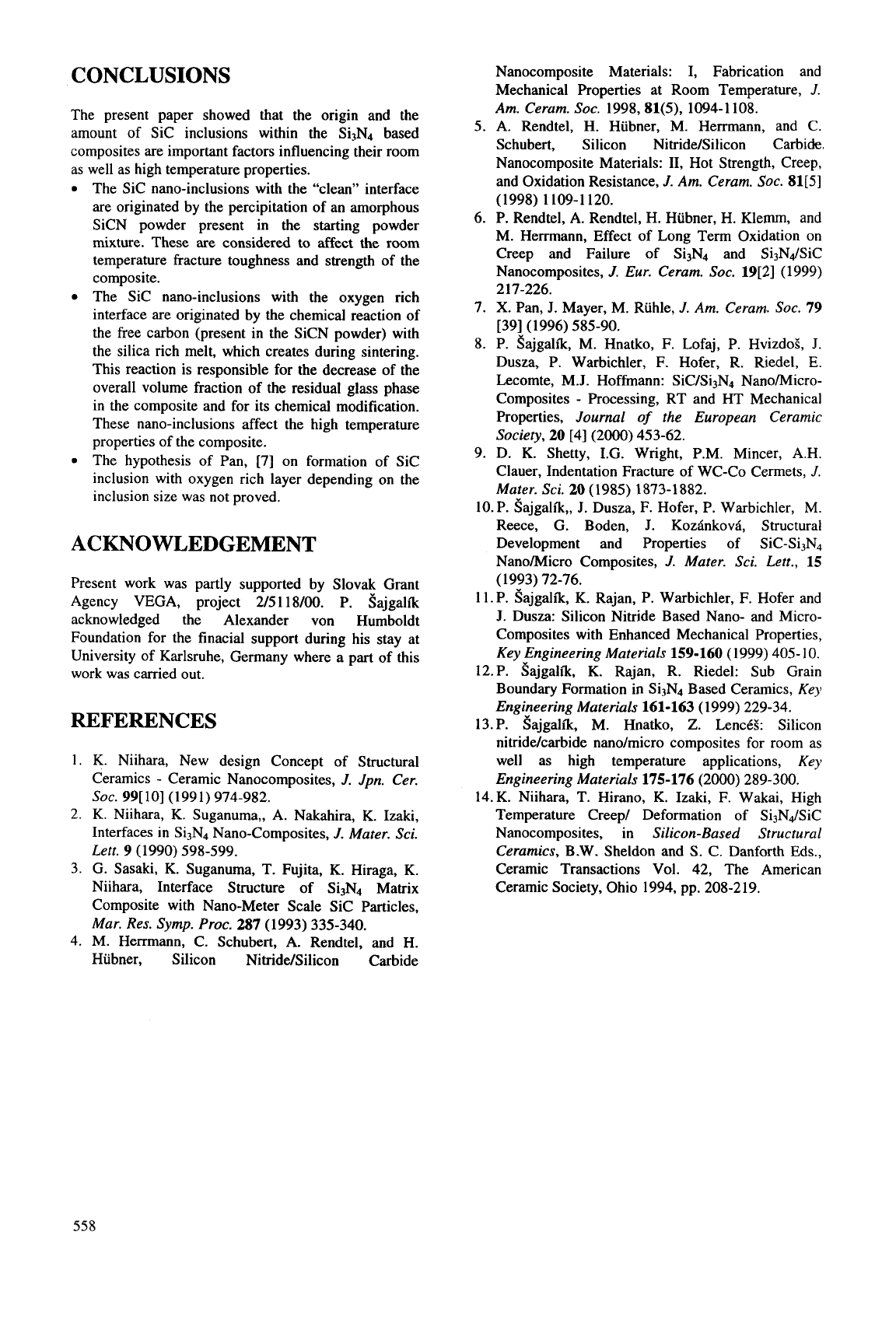
CONCLUSIONS
The present paper showed that the origin and the
amount of Sic inclusions within the Si3N4 based
composites are important factors influencing their room
as well as high temperature properties.
The Sic nano-inclusions with the “clean” interface
are originated by the percipitation of an amorphous
SiCN powder present
in
the starting powder
mixture. These are considered to affect the room
temperature fracture toughness and strength of the
composite.
The Sic nano-inclusions with the oxygen rich
interface are originated by the chemical reaction of
the free carbon (present in the SiCN powder) with
the silica rich melt, which creates during sintering.
This reaction is responsible for the decrease of the
overall volume fraction of the residual glass phase
in the composite and for its chemical modification.
These nano-inclusions affect the high temperature
properties
of
the composite.
The hypothesis of Pan,
[7]
on formation of Sic
inclusion with oxygen rich layer depending on the
inclusion size was not proved.
ACKNOWLEDGEMENT
Present work was partly supported by Slovak Grant
Agency VEGA, project 215 1 18/00. P. Sajgalik
acknowledged the Alexander von Humboldt
Foundation for the finacial support during his stay at
University of Karlsruhe, Germany where a
part
of this
work was carried out.
REFERENCES
K.
Niihara, New design Concept of Structural
Ceramics
-
Ceramic Nanocomposites,
J.
Jpn. Cer.
SOC.
99[10] (1991) 974-982.
K.
Niihara, K. Suganuma,,
A.
Nakahira, K. Izaki,
Interfaces in Si3N4 Nano-Composites,
J.
Muter. Sci.
Lett.
9
(1990) 598-599.
G.
Sasaki, K. Suganuma, T. Fujita, K. Hiraga, K.
Niihara, Interface Structure of
Si3N4
Matrix
Composite with Nano-Meter Scale Sic Particles,
Mar. Res. Symp. Proc.
287 (1993) 335-340.
M. Herrmann, C. Schubert, A. Rendtel, and H.
Hubner, Silicon Nitride/Silicon Carbide
Nanocomposite Materials:
I,
Fabrication and
Mechanical Properties at Room Temperature,
J.
Am. Ceram.
SOC.
1998,81(5), 1094-1 108.
5. A. Rendtel, H. Hubner,
M.
Henmann, and
C.
Schubert, Silicon Nitride/Silicon Carbide
Nanocomposite Materials: 11, Hot Strength, Creep,
and Oxidation Resistance,
J.
Am. Ceram.
SOC.
81[5]
6.
P. Rendtel, A. Rendtel, H. Hubner, H. Klemm, and
M. Henmann, Effect of Long Term Oxidation on
Creep and Failure of Si3N4 and Si3N4/SiC
Nanocomposites,
J.
Eur. Ceram.
SOC.
19[2] (1999)
7.
X.
Pan,
J.
Mayer, M. Ruhle,
J.
Am. Ceram.
SOC.
79
8. P. Sajgalik, M. Hnatko, F. Lofaj, P. HvizdoS,
J.
Dusza, P. Warbichler, F. Hofer, R. Riedel,
E.
Lecomte, M.J. Hoffmann: SiC/Si3N4 NanoMicro-
Composites
-
Processing, RT and HT Mechanical
Properties,
Journal
of
the European Ceramic
Society,
20
[4] (2000) 453-62.
9. D.
K.
Shetty, I.G. Wright, P.M. Mincer, A.H.
Clauer, Indentation Fracture
of
WC-Co Cermets,
J.
Mater.
Sci.
20
(1985) 1873-1882.
1O.P. Sajgalik,,
J.
Dusza, F. Hofer, P. Warbichler, M.
Reece,
G.
Boden,
J.
Kozinkovi, Structural
Development and Properties of SiC-Si3N4
Nano/Micro Composites,
J.
Muter. Sci. Left.,
15
1 l.P. Sajgalik, K. Rajan, P. Warbichler, F. Hofer and
3.
Dusza: Silicon Nitride Based Nano- and Micro-
Composites with Enhanced Mechanical Properties,
Key Engineering Materials
159-160
(1999)
405-
10.
12.P. Sajgalik,
K.
Rajan, R. Riedel: Sub Grain
Boundary Formation in Si3N4 Based Ceramics,
Key
Engineering Materials
161-163
(1999) 229-34.
13.P. Sajgalik, M. Hnatko,
Z.
LencBS: Silicon
nitridelcarbide nano/micro composites for room as
well as high temperature applications,
Key
Engineering Materials
175-176
(2000) 289-300.
14.K. Niihara, T. Hirano, K. Izaki, F. Wakai, High
Temperature Creep/ Deformation of Si3NdSiC
Nanocomposites,
in
Silicon-Based Structural
Ceramics,
B.W. Sheldon and
S.
C.
Danforth Eds.,
Ceramic Transactions Vol. 42, The American
Ceramic Society, Ohio 1994, pp. 208-219.
(1998) 1109-1 120.
217-226.
[39] (1996) 585-90.
(1993) 72-76.
558
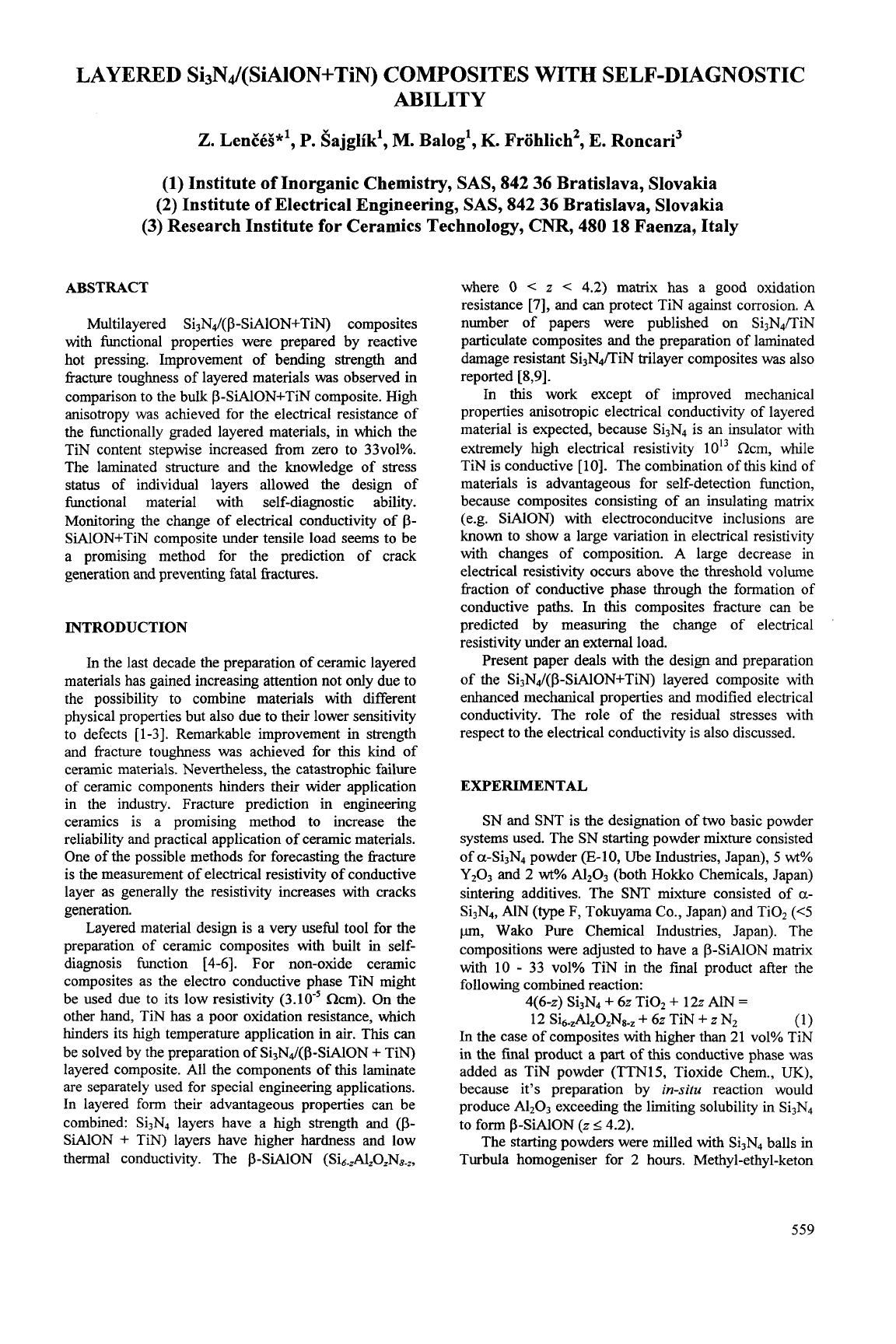
LAYERED Si3NJ(SiAlON+TiN) COMPOSITES WITH SELF-DIAGNOSTIC
ABILITY
Z.
LenEeS"',
P.
Sajglik',
M.
Balog',
K.
Frohlich', E. Roncari3
(1)
Institute
of
Inorganic Chemistry,
SAS,
842 36 Bratislava, Slovakia
(2) Institute of Electrical Engineering,
SAS,
842 36 Bratislava, Slovakia
(3) Research Institute for Ceramics Technology,
CNR,
480
18
Faenza, Italy
ABSTRACT
Multilayered Si3Nd(P-SiA10N+TiN) composites
with functional properties were prepared by reactive
hot pressing. Improvement of bending strength and
fracture toughness of layered materials
was
observed in
comparison to the bulk P-SiAlON+TiN composite. High
anisotropy was achieved for the electrical resistance of
the functionally graded layered materials, in which the
TiN content stepwise increased from zero to 33~01%.
The laminated structure and the knowledge of stress
status of individual layers allowed the design of
functional material with self-diagnostic ability.
Monitoring the change of electrical conductivity
of
p-
SiAlON+TiN composite under tensile load seems to be
a promising method for the prediction of crack
generation and preventing fatal fractures.
INTRODUCTION
In the last decade the preparation of ceramic layered
materials has gained increasing attention not only due to
the possibility to combine materials with different
physical properties but also due to their lower sensitivity
to defects
[
1-31.
Remarkable improvement in strength
and fracture toughness was achieved for
this
kind of
ceramic materials. Nevertheless, the catastrophic failure
of ceramic components hinders their wider application
in the industry. Fracture prediction in engineering
ceramics is a promising method to increase the
reliability and practical application of ceramic materials.
One of the possible methods for forecasting the fracture
is the measurement of electrical resistivity of conductive
layer as generally the resistivity increases with cracks
generation.
Layered material design is a very useful tool for the
preparation of ceramic composites with built in self-
diagnosis function
[4-61.
For non-oxide ceramic
composites as the electro conductive phase TiN might
be used due to its low resistivity
(3.10-'
SZcm). On the
other hand, TiN has a poor oxidation resistance, which
hinders its high temperature application in air. This can
be solved by the preparation of Si3N&3-SL410N
+
TiN)
layered composite. All the components of
this
laminate
are separately used for special engineering applications.
In layered
form
their advantageous properties can be
combined: Si3N4 layers have a high strength and
(p-
SiAlON
+
TiN) layers have higher hardness and low
thermal Conductivity. The P-SiAlON (Si6,AlzOzN8~z,
where
0
<
z
4.2)
matrix has a good oxidation
resistance
[7],
and can protect TiN against corrosion.
A
number of papers were published on Si3N4/TiN
particulate composites and the preparation of laminated
damage resistant Si3NdTiN trilayer composites was also
reported
[8,9].
In
this
work except of improved mechanical
properties anisotropic electrical conductivity of layered
material is expected, because Si3N4 is
an
insulator with
extremely
high
electrical resistivity
1013
Rcm, while
TiN is conductive
[lo].
The combination of this kind
of
materials is advantageous for self-detection fimction,
because composites consisting of an insulating matrix
(e.g.
SiAlON)
with electroconducitve inclusions are
known
to show a large variation in electrical resistivity
with changes of composition.
A
large decrease in
electrical resistivity occurs above the threshold volume
fraction of conductive phase through the formation of
conductive paths. In
this
composites fracture can be
predicted by measuring the change of electrical
resistivity under an external load.
Present paper deals with the design and preparation
of the Si3Nd(P-SiA10N+TiN) layered composite with
enhanced mechanical properties and modified electrical
conductivity. The role of the residual stresses with
respect to the electrical conductivity is also discussed.
EXPERIMENTAL
SN and SNT is the designation of
two
basic powder
systems used. The SN starting powder mixture consisted
of a-Si3N4 powder (E-1
0,
Ube Industries, Japan),
5
wt%
Y203
and
2
wt%
A1203
(both
Hokko
Chemicals, Japan)
sintering additives. The SNT mixture consisted of
a-
Si3N4, AlN (type F, Tokuyama Co., Japan) and Ti02
(<5
pn,
Wako
Pure Chemical Industries, Japan). The
compositions were adjusted to have a P-SiAlON matrix
with
10
-
33 vol% TiN in the final product after the
following combined reaction:
4(6-z)
Si3N4
+
62
TiOz
+
122
AlN
=
12
Si6.,Al,0zN8.,
+
62
TiN
+
2
N2
In the case of composites with higher than
21
vol% TiN
in the final product a part of
this
conductive phase was
added as TiN powder (TTN15, Tioxide Chem.,
UK),
because it's preparation by
in-situ
reaction would
produce A1203 exceeding the limiting solubility in Si3N4
The starting powders were milled with Si3N4 balls in
Turbula homogeniser for
2
hours. Methyl-ethyl-keton
(1)
to form
P-SiAlON
(Z
S
4.2).
559
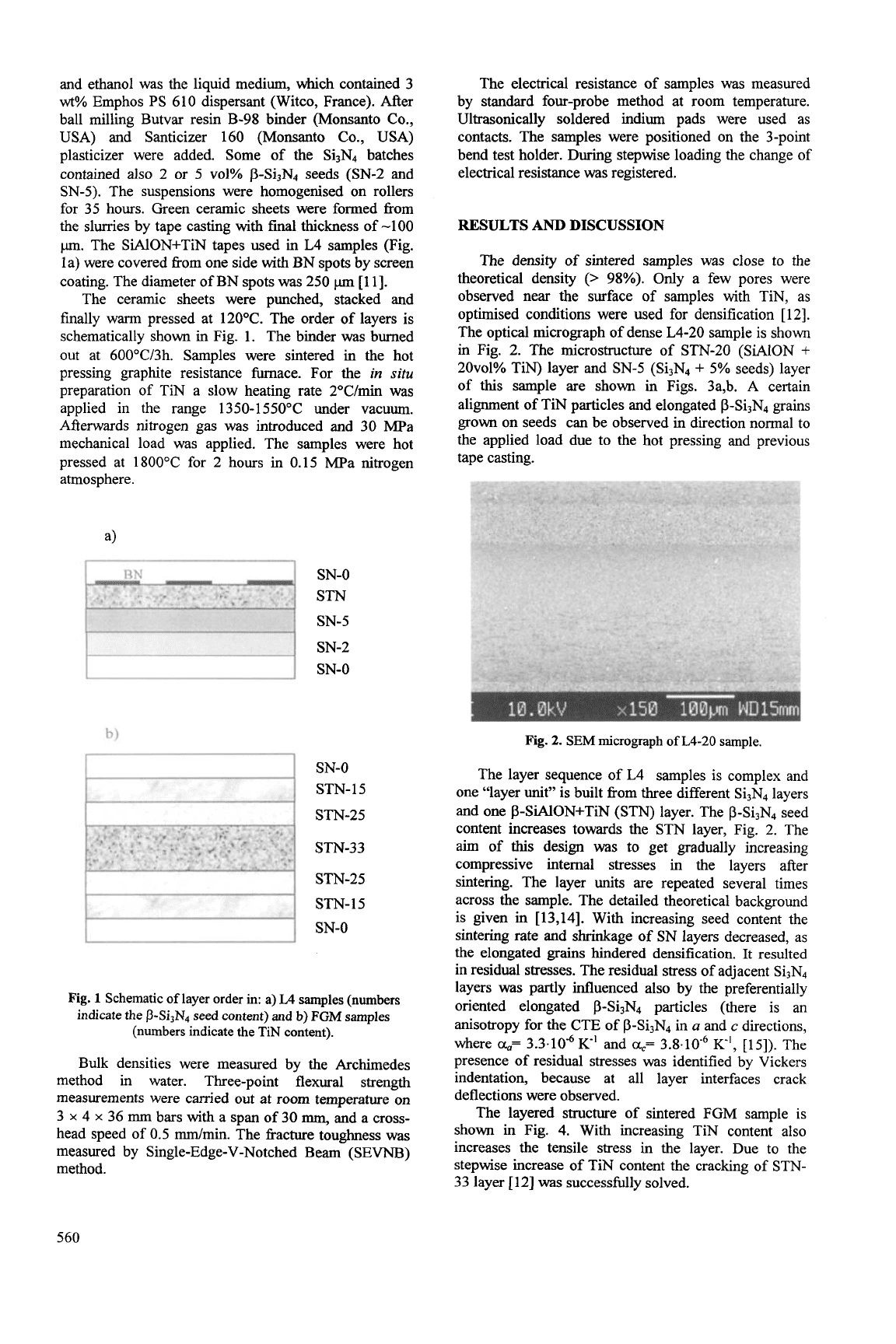
and ethanol was the liquid medium, which contained 3
wt%
Emphos
PS
610 dispersant (Witco, France). After
ball milling Butvar resin B-98 binder (Monsanto CO.,
USA) and Santicizer 160 (Monsanto Co., USA)
plasticizer were added. Some of the Si3N4 batches
contained also 2 or
5
vol% J3-Si3N4 seeds (SN-2 and
SN-5). The suspensions were homogenised on rollers
for 35 hours. Green ceramic sheets were formed fiom
the slurries by tape casting with
final
thickness of -100
pm.
The SMON+TiN tapes used
in
L4 samples (Fig.
1 a) were covered &om one side with BN spots by screen
coating. The diameter of BN spots
was
250
pm
[l
13.
The ceramic sheets were punched, stacked and
finally warm pressed at 120°C. The order of layers is
schematically shown in Fig. 1. The binder
was
burned
out at 60OoC/3h. Samples were sintered in the hot
pressing graphite resistance fiunace. For the
in
situ
preparation of TiN a slow heating rate 2"Clmin
was
applied in the range 1350-1550°C under vacuum.
Afterwards nitrogen gas was introduced and
30
MPa
mechanical load was applied. The samples were hot
pressed at 1800°C for 2 hours in 0.15 MPa nitrogen
atmosphere.
4
I
I
SN-0
STN
SN-5
SN-2
SN-0
SN-0
STN-15
STN-25
STN-33
STN-25
STN-15
SN-0
I
I
Fig.
1
Schematic
of
layer order in: a)
L4
samples (numbers
indicate the P-Si,N, seed content) and
b)
FGM
samples
(numbers indicate the TiN content).
Bulk densities were measured by the Archimedes
method in water. Three-point flexural strength
measurements were carried out at room temperature on
3
x
4
x
36
rnm
bars with a span
of
30
mm,
and a cross-
head speed of
0.5
mm/min.
The fiacture toughness
was
measured by Single-Edge-V-Notched Beam
(SEVNB)
method.
The electrical resistance of samples was measured
by standard four-probe method at room temperature.
Ultrasonically soldered indium pads were used as
contacts. The samples were positioned on the 3-point
bend test holder. During stepwise loading the change of
electrical resistance
was
registered.
RESULTS
AND
DISCUSSION
The density of sintered samples was close to the
theoretical density
(>
98%). Only a few pores were
observed near the surface of samples with TiN, as
optimised conditions were used for densification
[
121.
The optical micrograph of dense L4-20 sample is
shown
in Fig. 2. The microstructure of STN-20
(SiAION
+
20~01% TiN) layer and SN-5 (Si3N4
+
5%
seeds) layer
of
this
sample are shown
in
Figs. 3a,b.
A
certain
alignment
of
TiN particles and elongated p-Si3N4 grains
grown on seeds can be observed
in
direction normal to
the applied load due to the hot pressing and previous
tape casting.
Fig.
2.
SEM
micrograph
of
L4-20
sample.
The layer sequence of L4 samples is complex and
one "layer unit" is built fiom three different Si3N4 layers
and one P-SiAlON+TiN (STN) layer. The p-Si3N4 seed
content increases towards the STN layer, Fig. 2. The
aim of this design
was
to get gradually increasing
compressive internal stresses in the layers after
sintering. The layer units are repeated several times
across the sample. The detailed theoretical background
is given in [13,14]. With increasing seed content the
sintering rate and shrinkage of SN layers decreased, as
the elongated
grains
hindered densification. It resulted
in residual stresses. The residual stress of adjacent Si3N4
layers
was
partly influenced also by the preferentially
oriented elongated p-Si3N4 particles (there is an
anisotropy for the CTE of p-Si3N4 in
a
and
c
directions,
where
%=
3.3.104
K'
and
ac=
3.8.10-6
K',
[15]).
The
presence
of
residual stresses
was
identified by Vickers
indentation, because at all layer interfaces crack
deflections were observed.
The layered structure of sintered FGM sample is
shown in Fig.
4.
With increasing TiN content also
increases the tensile stress in the layer. Due to the
stepwise increase of TiN content the cracking of STN-
33 layer [12]
was
successfully solved.
560
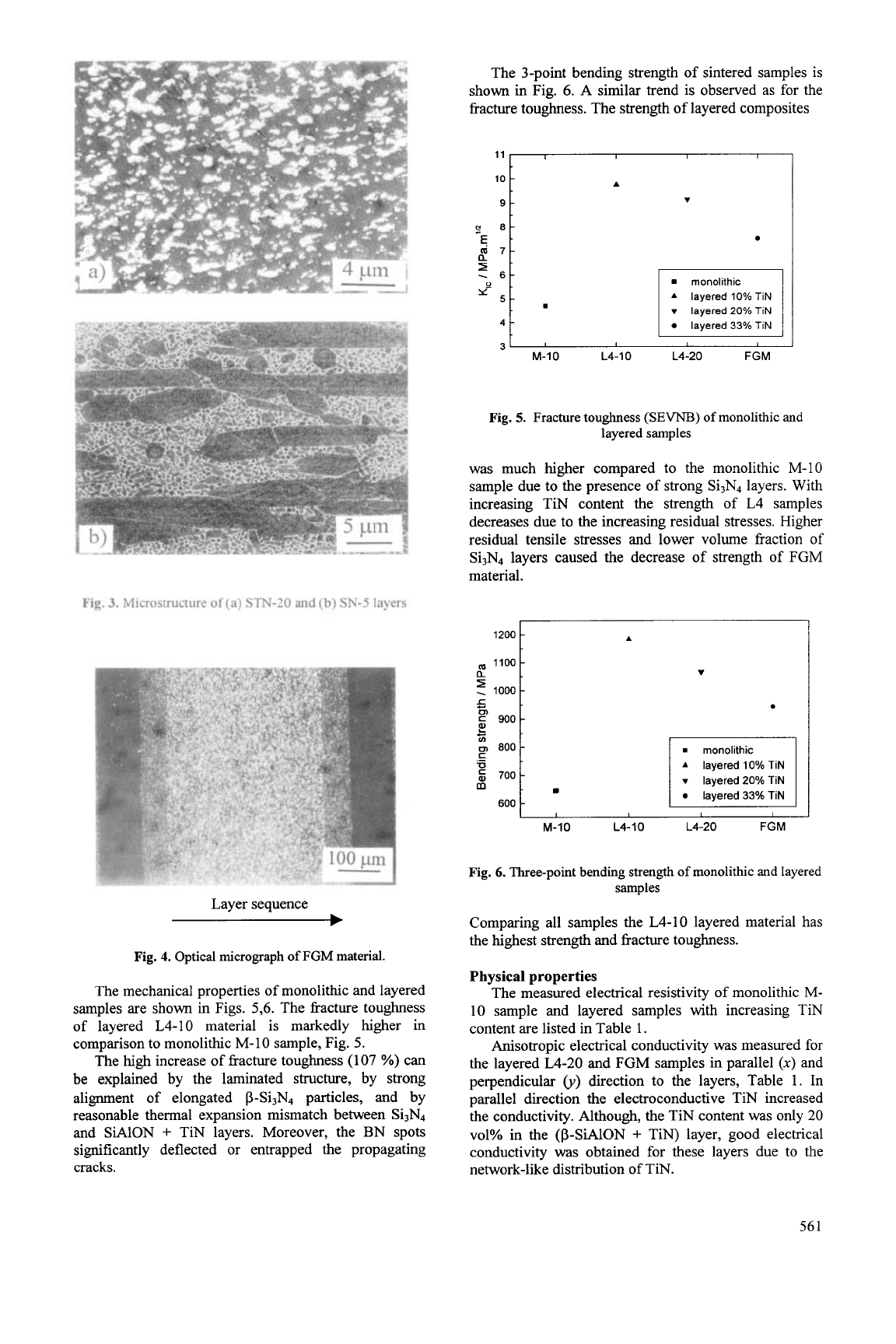
The 3-point bending strength of sintered samples is
shown
in
Fig.
6.
A similar trend is observed as for the
fracture toughness. The strength
of
layered composites
10
9-
8-
11
I
I I
-
5
p!
F
900
L
u)
C
U
o,
800
5
700
.-
m
600
A
-
-
-
-
v
layered 10%
TIN
layered
20%
TiN
4
layered
33%
TiN
3
M-I
0
L4-10 L4-20
FGM
Fig.
5.
Fracture toughness
(SEW)
of
monolithic and
layered samples
was much higher compared to the monolithic
M-10
sample due to the presence
of
strong Si3N4 layers. With
increasing TiN content the strength of
L4
samples
decreases due to the increasing residual stresses. Higher
residual tensile stresses and lower volume fraction
of
Si3N4 layers caused the decrease
of
strength
of
FGM
material.
Fig.
3.
Microstructure
of
(a) STN-20 and (b)
SN-5
layers
1100
5
1000
a
A
v
Layer sequence
-
Fig.
4.
Optical micrograph
of
FGM material.
The mechanical properties of monolithic and layered
samples are shown in Figs.
5,6.
The fracture toughness
of layered
L4-10
material is markedly higher
in
comparison to monolithic
M-10
sample, Fig.
5.
The high increase of fkacture toughness
(107
%)
can
be explained by the laminated structure, by strong
alignment
of
elongated P-Si3N4 particles, and by
reasonable thermal expansion mismatch between Si3N4
and SiAlON
+
TiN layers. Moreover, the
BN
spots
significantly deflected or entrapped the propagating
cracks.
.
M-10
L4-10 L4-20
FGM
Fig.
6.
Three-point bending strength
of
monolithic
and
layered
samples
Comparing all samples the
L4-10
layered material has
the highest strength and fkacture toughness.
Physical properties
The measured electrical resistivity of monolithic
M-
10
sample and layered samples with increasing TiN
content are listed in Table
1.
Anisotropic electrical conductivity was measured for
the layered
L4-20
and
FGM
samples in parallel
(x)
and
perpendicular
@)
direction to the layers, Table 1. In
parallel direction the electroconductive TiN increased
the conductivity. Although, the TiN content was only
20
vol% in the (p-SiAlON
+
TIN) layer, good electrical
conductivity was obtained for these layers due to the
network-like distribution
of
TiN.
561
